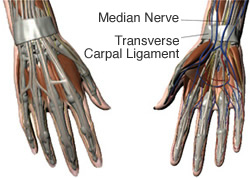What is carpal tunnel syndrome and who develops it?
The “carpal tunnel” is a narrow passageway that runs from the base of the hand through the wrist. The median nerve, which controls our sense of touch in the palm, and touch and fine movement in the thumb and three larger fingers, passes through the carpal tunnel along with several tendons. If any of those tendons become irritated, or any other swelling encroaches on the space within the tunnel, the median nerve can become compressed. Compression of the median nerve may cause symptoms that range from tingling in the fingers to pain radiating up the arm.
Three out of every four people who develop carpal tunnel syndrome are women. Some researchers suggest that women develop the syndrome more frequently because of simple differences in anatomy – women have a smaller carpal tunnel than men. Other factors may also be important in determining the cause of the syndrome. Heredity, repetitive and forceful hand use, hormonal changes, and other medical conditions like arthritis and diabetes, have all been linked to carpal tunnel syndrome.

What are the symptoms of carpal tunnel syndrome?
The symptoms of carpal tunnel syndrome often begin gradually and typically stem from the thumb side of the hand. Initially, symptoms may be intermittent (come and go), but without intervention, they may become chronic (constant). You may feel tingling, numbness and pain in your hand. This pain may also radiate through your wrist and up your arm. Pain associated with carpal tunnel may feel dull and nagging, or it may seem to shoot through your hand, wrist and arm like an electrical current. Tasks that require small finger movements, like tying a shoe or fastening a necklace clasp,may become difficult. Sometimes flexing your wrist or shaking out your hand may temporarily reduce or relieve the discomfort.
In order to diagnose you properly, your doctor will consider your symptoms, examine your hand and wrist, and ask you to perform specific movements that reproduce the symptoms of carpal tunnel syndrome. Your doctor may also require you to have X-rays, an MRI (magnetic resonance imaging) or a nerve conduction test to look closely at the nerve function in your hand.
Next Page >>